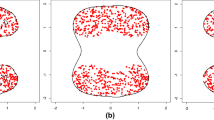Abstact
In this paper, we propose to use a support vector machine (SVM) for the classification of design data. Although the SVM is a very popular technique in data mining, it is rarely applied to an industrial design process that may require information regarding the feasibility of the design point of interest. To check the feasibility, the designer must conduct experiments or computer simulations, which may incur considerable cost. Therefore, the SVM can be an effective tool for predicting feasible and infeasible regions because it only uses the cumulative design data. In this paper, we used the SVM to classify sample datasets drawn from mathematical test problems and from an air-conditioner pipe design example. Our results indicate that the SVM is capable of very accurately identifying feasible and infeasible regions in the design space. Further, we were able to reduce the training time of the SVM by using the k-means clustering algorithm to reduce the amount of training data, taking advantage of the powerful generalization abilities of the SVM. Consequently, we conclude that the SVM can be an effective tool to assess feasibility at certain design points, avoiding some of the high computational costs of the analysis.
Similar content being viewed by others
References
Ding, M. and Vemur, R. I., “An Active Learning Scheme Using Support Vector Machines for Analog Circuit Feasibility Classification,” Proc. of the 18th International Conference on VLSI Design, pp. 528–534, 2005.
Burdidge, R., Trotter, M., Buxton, B. and Holden, S., “Drug Design by Machine Learning: Support Vector Machines for Pharmaceutical Data Analysis,” Computers and Chemistry, Vol. 26, No. 1, pp. 5–14, 2001.
Boser, B. E., Guyon, I. M. and Vapnik, V. N., “A Training Algorithm for Optimal Margin Classifiers,” Proc. of the 5th Annual ACM Workshop on COLT, pp. 144–152, 1992.
Ben-Hur, A. and Weston, J., “A User’s Guide to Support Vector Machines,” Methods in Molecular Biology, Vol. 609, pp. 223–239, 2010.
Joachims, T., “Transductive Inference for Text Classification using Support Vector Machines,” Proc. of the 16th International Conference on Machine Learning, pp. 200–209, 1999.
Osuna, E., Freund, R. and Girosi, F., “Training Support Vector Machines: An Application to Face Detection,” IEEE Computer Society Conference on Computer Vision and Pattern Recognition, pp. 130–136, 1997.
Cho, K. R., Seok, J. K. and Lee, D. H., “Applications of mechanical parameter identification with support vector machine for AC motor control system,” Proc. of the 30th Annual Conference of the IEEE Industrial Electronics Society, Vol. 3, pp. 2110–2115, 2004.
Pan, Y. R., Shih, Y. T., Horng, R. H. and Lee, A. C., “Advanced Parameter Identification for a Linear-Motor-Driven Motion System Using Disturbance Observer,” Int. J. Precis. Eng. Manuf., Vol. 10, No. 4, pp. 35–47, 2009.
Lee, D. M., Zhu, Z., Lee, K. I. and Yang, S. H., “Identification and Measurement of Geometric Errors for a Five-axis Machine Tool with a Tilting Head using a Double Ball-bar,” Int. J. Precis. Eng. Manuf., Vol. 12, No. 2, pp. 337–343, 2011.
Shin, H. J. and Cho, S. Z., “Fast Pattern Selection for Support Vector Classifiers,” Advances in Knowledge Discovery and Data Mining, Vol. 2637, pp. 376–387, 2003.
Barros de Almeida, M., De Padua Braga, A. and Braga, J. P., “SVM-KM: Speeding SVMs Learning with a Priori Cluster Selection and k-Means,” Proc. of the 6th Brazilian Symposium on Neural Networks, pp. 162–167, 2000.
Koggalage, R. and Halgamuge, S., “Reducing the Number of Training Samples for Fast Support Vector Machine Classification,” Neural Inform. Process. Lett. Rev., Vol. 2, No. 3, pp. 57–65, 2004.
Zheng, S. F., Lu, X. F., Zheng, N. N. and Xu, W. P., “Unsupervised Clustering Based Reduced Support Vector Machines,” Proc. of the IEEE International Conference on Acoustics, Speech, and Signal Processing (ICASSP), Vol. 2, pp. 821–824, 2003.
Hock, W. and Schittkowski, K., “Test Examples for Nonlinear Programming Codes,” Springer, 1981.
Kim, R. H., “Design Optimization of an Air-Conditioner Pi** System to Reduce the Cost of Pipes,” M.Sc. Dissertation, Department of Mechanical & Industrial Engineering, Hanyang Univ., 2008.
Cortes, C. and Vapnik, V., “Support-Vector Networks,” Machine Learning, Vol. 20, No. 3, pp. 273–297, 1995.
Cristianini, N. and Shawe-Taylor, J., “An Introduction to Support Vector Machines and Other Kernel-based Learning Methods,” Cambridge University Press, 2000.
Jain, A. K. and Dubes, R. C., “Algorithms for Clustering Data,” Prentice Hall College Div., pp. 89–133, 1998.
Mathworks Inc., “Matlab Optimization Toolbox User’s Guide,” 2007.
PIDOTECH Inc., “PIAnO (Process Integration, Automation, and Optimization) User’s Manual Ver. 3.3,” 2011.
Author information
Authors and Affiliations
Corresponding author
Rights and permissions
About this article
Cite this article
Jeong, SH., Choi, DH. & Jeong, M. Feasibility classification of new design points using support vector machine trained by reduced dataset. Int. J. Precis. Eng. Manuf. 13, 739–746 (2012). https://doi.org/10.1007/s12541-012-0096-1
Received:
Accepted:
Published:
Issue Date:
DOI: https://doi.org/10.1007/s12541-012-0096-1




